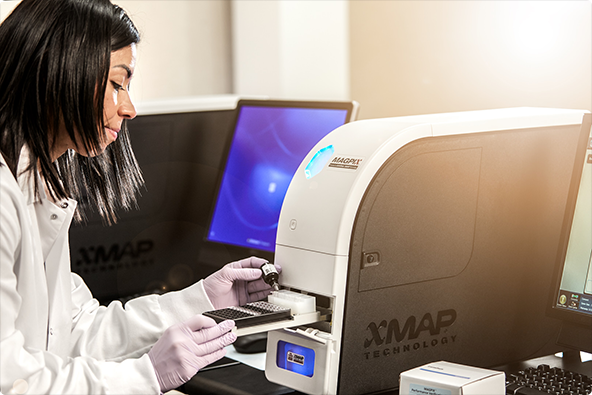Luminex Partner Tetracore designed a serology assay for SARS-CoV-2 using xMAP® Technology.

A new multiplex serology test to determine whether someone has been exposed to the SARS-CoV-2 virus is coming soon, thanks to assay developer Tetracore. The company—one of Luminex’s research partners—developed this test based on our xMAP Technology. We spoke with Tetracore Senior Scientist Neeraja Venkateswaran to learn more about the test and how it can help fight the COVID-19 pandemic.
Q: Many SARS-CoV-2 serology tests in development focus on one antibody. Why was it important to your team to take a multiplex approach?
A: It’s based on our experience with infectious disease testing. When Zika happened, we saw that an ELISA-based serology test had high cross-reactivity with dengue fever. This is always an issue when looking at only one antigen at a time. At the time, we used the Luminex platform to develop a very complex panel with several different antigens to detect whether a patient was positive for dengue or for Zika.
Q: What did you learn from the multiplex Zika test?
A: When the dust settled from that outbreak, we realized that there was a problem with the single ELISA assay. All of these RNA viruses have many conserved domains. Since dengue and Zika looked similar to the immune system, we saw that patients who had been previously infected with dengue and were exposed with Zika began producing the old dengue antibodies at first, because that’s the body’s response when it recognizes some of those conserved domains.
Q: How did that inform your approach to testing for SARS-CoV-2?
A: The moment that SARS-CoV-2 hit, we thought that people who had been exposed to the original SARS virus and now got the new virus would start making antibodies for SARS first, because their immune system would remember that. We knew that a serology test would have to be able to distinguish between SARS, MERS, and SARS-CoV-2—this is why a multiplex test is so important. We immediately began screening antigens available for SARS, and now we have created a test that successfully discriminates between SARS, MERS, and SARS-CoV-2.
Q: With so many molecular assays for SARS-CoV-2 now available, what’s the role of a serology test?
A: Serology tests tell us who’s been exposed, including people who were asymptomatic or who had symptoms but missed the window for molecular testing. Detecting a robust IgG response could identify people who are safe to go back to work. Serology is also very important for understanding the epidemiology of disease, determining whether we have developed herd immunity, and conducting routine surveillance. Once there are vaccines ready for testing, we will need to see the human immune response to them—serology can be applied for that, too.
Q: Why did you choose the xMAP® platform for your multiplex tests?
A: I have been working with the xMAP platform for years. Once you use xMAP Technology, you don’t ever want to do an ELISA again. We don’t test for a single target when we do nucleic acid testing, and I believe we should look for more than one antigen for any pathogen. Luminex gives me the ability to do that. It also lets me put an internal control into every single reaction, which can’t be done with ELISA testing.
Interested in learning more about Luminex’s SARS-CoV-2 testing solutions? Check out our website.
